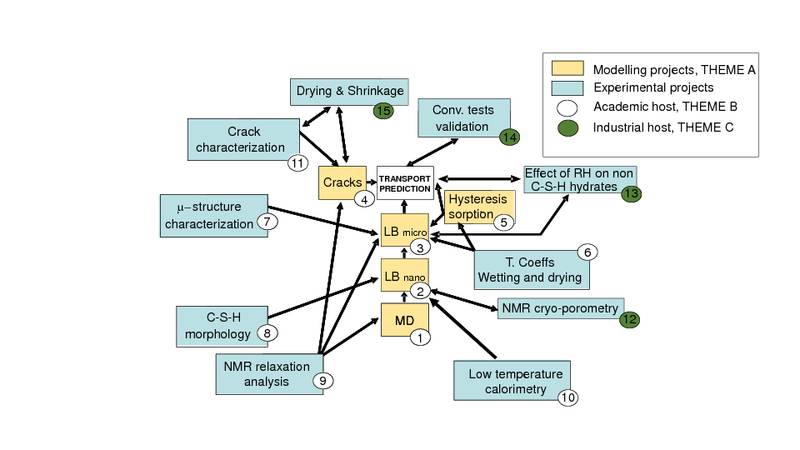MC ITN TRANSCEND
Work Programme
The TRANSCEND work programme including modelling of water dynamics and experimental work providing input data to validate the modelling
The work programme is divided into three principal themes and fifteen projects for fifteen Early Stage Researchers.
- Theme A
Modelling of water dynamics in cement pastes. - Theme B
Experimental work to provide input data to the modelling. - Theme C
Experimental work to validate the modelling.
Theme A: modelling of water dynamics in cement pastes
Theme A comprises five projects that systematically build a theoretical understanding of water dynamics in cements and concretes at a hierarchy of length scales starting from atomistic (molecular dynamics, MD) simulations of water within the layered structure of C-S-H (nanometres) through to finite element models based on analytic differential equations in concrete (metres).
Two of the projects look particularly at the problems of adsorption /desorption and hysteresis, important as most concrete is subject to variable humidity conditions (rain, sun, etc)
Projects in theme A Modelling
Partners
1 ESR; Host: Surrey, Industrial Advisor: Lafarge
Objectives
To test emergent understanding of water dynamics in cement at the atomic level against theoretical predictions based on molecular dynamic simulations.
Partners
1ESR; Host: Cambridge, Industrial Advisor: Lafarge
Objectives
To build a coupled solid / liquid phase Lattice Boltzmann (LB) model of small gel regions of C‑S-H and validate against experimental visualisations of morphology.
Project #'03' - Lattice Boltzmann Modeling of Water Dynamics in Cement Paste
Partners
1 ESR; Host: EPFL, Industrial Advisors: Holcim & Simco
Objectives
To build a predictive and validated lattice Boltzmann model of water dynamics in cement paste as an add-on to the structural code µic.
Project #'04' - The Role of µ-cracks in Concrete on Water Transport
Partners
1 ESR; Host: Imperial, Industrial Advisors: Sika
Objectives
To understand how micro-cracks develop in concrete and to model the role of microcracks in different transport processes and in the acceleration of deterioration.
Partners
1ESR; Host: IFSTTAR (ex-LCPC), Industrial Advisor: Heidelberg & Elkem
Objectives
To model water absorption and desorption in a range of cements, cement analogues and concrete.
Theme B: experimental work to provide input data to the modelling.
Theme B comprises 6 projects that build the experimental parameter data-base needed as input to the modelling developed in Theme A. Projects 6 and 7 develop the characterisation of materials and transport coefficients. Project 7 additionally provides a materials bank for other projects. Project 10 develops cryo-porometry as a new technique for the characterisation of water filling / emptying of nano-pores in cements. Project 8 characterises the morphology of C-S-H, including synthesised C-S-H much used as a test material. Project 11 maps micro-cracks in concrete using ion beam methods and develops as a tool for others to use. Likewise Project 9 develops and disseminates magnetic resonance methods.
Projects in theme B experimental
Partners
1ESR; Host: Lund, Industrial Advisor: Heidelberg & Simco
Objectives
To experimentally determine water transport pathways, mechanisms and coefficients in cements, cement analogues and concretes to support the modelling theme, especially P 5.
Project #'07' - Porosity Characterisation
Partners
1ESR; Host: EPFL, Industrial Advisor: Holcim & Intron
Objectives
To develop a materials databank and characterise the microstructure of the cementitious materials used within other research projects including quantification of solid phases, their distribution and porosity.
Partners
1 ESR; Host: Leeds, Industrial Advisor: Holcim
Objectives
To determine the morphology of C-S-H and whether links exist between composition, structure and morphology or whether it is only kinetically controlled.
Project #'09' - NMR Imaging and Relaxation Analysis
Partners
1 ESR Host: Surrey, Industrial Advisor: Lafarge
Objectives
To provide the NMR relaxation and Magnetic Resonance Imaging (MRI) data required to support the atomic level modelling (Ps 1, 2) and modelling of transport in cements and concretes (Ps 3, 4, 5).
Project #'10' - Cryoporometry Characterisation for Cement Based Materials
Partners
1 ESR; Host: DTU, Industrial Advisor: Lafarge
Objectives
To (i) better understand water absorption / desorption hysteresis effects; (ii) create a new perspective on understanding C-S-H porosity and (iii) understand freezing behaviour of pore liquid in cementitious materials.
Partners
1 ESR; Host: UPC-Imperial College London, Industrial Advisor: Sika
Objectives
To develop experimental techniques for the micro/nanoscale characterisation of cracks and phase distribution in mortar and concrete through 2D and 3D integrated in-situ imaging of physico-chemical tomography.
Theme C: experimental work to validate the modelling.
Theme C comprises four projects that together validate the output at the different length scales of the modelling programme (Theme A). These projects are hosted by and conducted within the private sector partners by the industrial doctorate Early Stage Researchers to ensure high end-user relevance of the overall programme.
Projects in theme C validation
Partners
1 ESR (Industrial Doctorate); Host: Lafarge, Academic Partner for Industrial PhD: EPFL
Objectives
To make experimental measurements to validate the emergent picture, from Ps 1, 2, 5 and 8, of water dynamics in synthetic C-S-H and C-S-H analogues.
Project #'13' - Impact of Mineralogy on the Water Balance of Cement Paste
Partners
1 ESR (Industrial Doctorate); Host: Holcim, Academic Partner for Industrial PhD: EPFL
Objectives
To validate and apply the derived model with respect to water transport properties of hydrating cement/concrete systems.
Partners
1 ESR (Industrial Doctorate); Host: HeidelbergCement, Academic partner for Industrial PhD: EPFL
Objectives
To test emergent understanding of the scientific basis to established tests for water dynamics and transport in cement based materials
Project #'15' - Validation of Modelling with Respect to Drying and Shrinkage
Partners
1 ESR and 1 ER ; Host: Sika, Academic partner: EPFL
Objectives
To validate developed models of water transport in systems where shrinkage and hence cracking upon curing / drying is notable.
